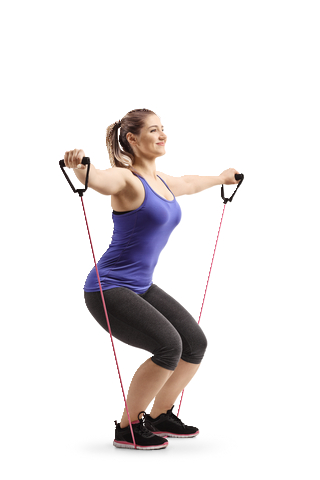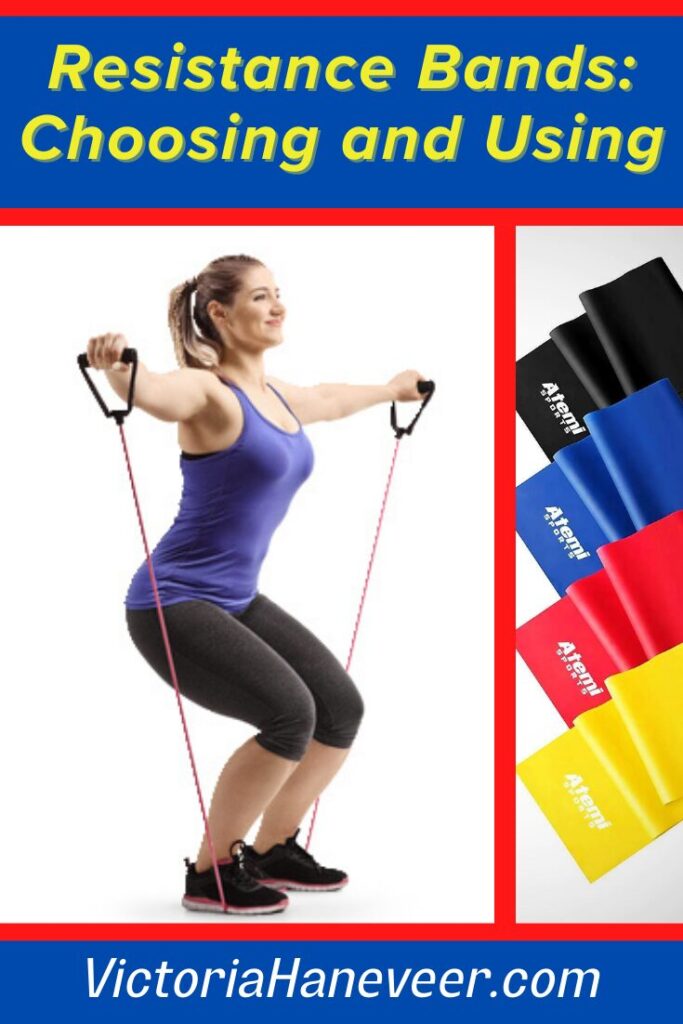You’ve probably heard of resistance bands before and maybe used them yourself. They date back to the early 1900s but of course have come a long way since then! A resistance band is an elastic band which doesn’t weigh much. It’s used to help the muscles contract. This strengthens the muscles as you pull against the band.
It’s a basic concept but works really effectively for fitness. The earliest ones were used for physiotherapy and rehabilitation, since they could be used to help damaged muscles recover. They are still used for that purpose today but are also good for anybody who wants to strengthen their muscles.
Resistance bands can be made from latex or latex alternatives. They come in different strengths and thicknesses. The resistance works when you try to stretch the band out.
So, what resistance bands should I buy, you might be asking yourself. Let’s take a look at some of the most popular types, as well as what you can do with them.
Table of Contents
Heavy Duty Resistance Bands
These multi-purpose bands can be used for rehabilitation, warming up, mobility, and static stretching. They are an alternative to weight training.
Heavy duty resistance bands can both help you to train and provide effective resistance exercise.
Use them for dips, pull-ups, muscle-ups, and various calisthenics exercises.
You can also use them for bench presses and barbell squats if you use a squat rack.
Banded leg presses or banded squats, for example, add more resistance to the whole lift.
Usually you will have less resistance when reaching the top of the lift, but that doesn’t apply when using resistance bands.
Flat vs Tube Bands
Flat resistance bands are strips of rubber and good for rehabilitation or physiotherapy.
They are less durable than tube resistance bands which are better for adding extra resistance to stretch or work their muscles.
Guide to Resistance Band Levels and Color
Resistance bands come in various types and colors according to how much resistance they give. You can use them by themselves or combine them with free weights, depending which exercises you want to do. The colors and levels vary according to the brand.
Thera-band is one of the most popular brands, and these are the different colors for that brand:
- Yellow: Extra-light resistance for shins and shoulders
- Red: Light resistance for triceps and biceps
- Green: Medium resistance for legs, back and chest
- Blue: Heavy resistance for legs, back and chest
- Black: Extra-heavy resistance for legs, back and chest
The blue and black Thera-band ones are good if you’re working out with a partner.
If you prefer a broader range, you might like to consider the Cando-band brand:
- Tan: XX-light resistance
- Yellow: Extra-light resistance
- Red: Light resistance
- Green: Medium resistance
- Blue: Heavy resistance
- Black: Extra-heavy resistance
- Silver: XX-heavy resistance
- Gold: XXX-heavy resistance
If you are buying another brand and you aren’t sure which resistance is which color, just look at the price. The price goes up the heavier the resistance gets.
To figure out which you need, you should be able to perform two or three sets of ten to fifteen repetitions with slow and controlled movements and feel a little tired on the final set. When you can perform all three sets with no tiredness at the end, you can go up a color (resistance) level.
How Many Resistance Bands in a Set?
Most resistance bands come in sets of three, four or five, so you can target upper and lower muscles and different areas of your body. The measure resistance bands use is libres or ‘lbs’ (pounds) so the higher the libre, the stronger the resistance.
It’s usually best to get at least three bands: light, medium and heavy. That way you will have the right band for each major muscle group.
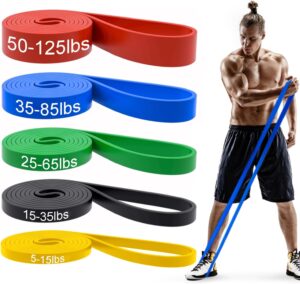
What Length of Resistance Bands to Choose
The length of the bands depends on the exercises you want to use them for. Ones that are 50 to 70cm long are meant for upper body exercises such as those for shoulders, neck and arm muscles.
If you want a full body workout though, you’ll need a 150cm length resistance band. That way it’s long enough to twist your waist and do leg stretches without risk of snapping the band.
Resistance Band Handles
Most of these bands come with handles. Some have interchangeable handles in different sizes. Padded handles are the most comfortable and ones you don’t have to change out when changing to another band are more convenient.
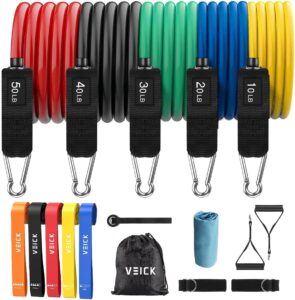
Benefits of Resistance Bands
Resistance bands don’t have a negative impact on tendons and joints like free weights can, but they will still stimulate the muscles in a similar way. They target the muscles more directly which makes it a safer exercise. You can also increase or decrease the intensity by changing the type of band you’re using.
A resistance band is small, inexpensive and portable. You can use it pretty much anywhere and use it to have better control when exercising.
Resistance bands are versatile enough to use one or more at the same time, and you can also combine them with weights for a more intense workout. Resistance bands can be stowed in a drawer or small closet while you’re traveling. They’re great if you don’t have a lot of room for workout equipment.
One of the best benefits of resistance bands is they can give you a full body workout. There are resistance band exercises you can use to train your arms, legs, back, shoulders, chest, and core. Invest in a great set of bands and you can tone every major muscle group you have.
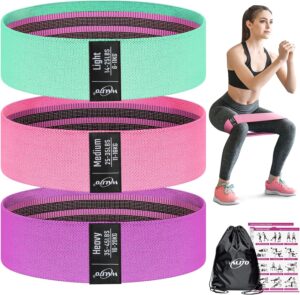
Resistance Bands are for Everyone
Whether you’re a man or woman, young or old, out of shape or fit, resistance bands offer a safe and effective way to exercise. They’re great to use at home, in the gym or when you’re travelling because they hardly weight anything or take up much room. This means wherever you happen to be, you can get a workout.
Adding a resistance band to pull-ups can train your body to be stronger and help get your chest up to the bar. Also, adding a band to a pulling exercise like a bicep curl or a deadlift ups the ante on resistance and enables you to get more out of the lift. If you aren’t ready to move up to the next weight but you still want to challenge yourself, simply add a resistance band to the lift.
A resistance ban can increase your coordination. They work like a cable machine so you can keep tension on the muscle constantly. You will also be using more stabilizer muscles to keep the band aligned during the exercises. This adds a new dynamic to the same old moves. It also helps you to involve more muscle groups in balance and coordination exercises.
Stretching with Bands
Resistance bands are great for stretching because you can get into positions you might not otherwise be able to and you can get a deeper stretch.
Whether you are already fit and looking for a new challenge or you’re just starting out, there is a perfect resistance band or resistance band set for you. Resistance band exercises include resisted box jumps, resisted sprints, resisted bear crawls, resisted push-ups, and more.
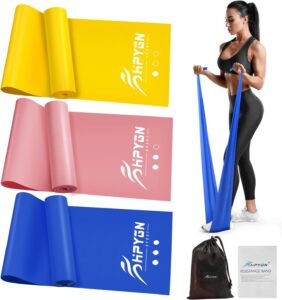
Strength Training with Resistance Bands
The main use of these bands is to build core strength. You can change the length of the bands to regulate how much resistance you get. The more resistance your muscles have, the harder they will work. Using these bands on a regular basis means you can test your muscle limits and build muscle strength.
Since you can wrap resistance bands around things, they can be used to up the ante on normal exercises. Put one around your back and under your palms to make push-ups more challenging, for example. Attach the bands on each side of a dumbbell to increase the difficulty of the squat and bench press. They’re great to help with the top of the lift since that’s where they are most stretched.
If you want to take your workout to a new level or try something new, resistance bands are great. They offer overall body strengthening as well as mobility enhancement, and they are kind to joints and low-impact. A resistance band can go with you anywhere and act as your all in one gym.
Resistance Bands for Mobility
You can really improve your mobility and flexibility using resistance bands. This can help you get a better workout and also help prevent injuries. Stretching might not be the most exciting thing you do at the gym but it is one of the most important ones. This is because the effectiveness of a workout depends largely on your flexibility.
You can do some good stretches if you have a training partner to help push the muscle to its limits, although not everyone has a partner. You can use resistance bands to deepen the stretch though and pull the lower and upper leg muscles further into a stretch.
Wrap the bands around and under your limbs to pull the muscles into deep stretches and lengthen them. Some people might find a lying down hamstring stretch challenging, but if you wrap the band under your foot, it’s much easier to raise the leg up.
Resistance bands are also good for warming up and cooling down. You can move your muscles through a whole range of motion and also do some gentle strengthening exercises before the main workout. This means resistance bands are very important, since they can be part of a routine or paired with various other exercise equipment.
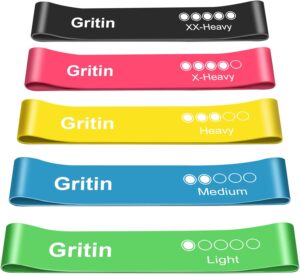
Pull-Up Bands
Also known as pull-up resistance bands, pull-up bands are specially designed for doing pull-ups. It can be hard to get started doing pull-ups, even experienced athletes. If you aren’t strong enough to pull your body up, it can be hard to build the required muscles for doing so.
A pull-up resistance band enables you to practice the pull-up motions without straining your arms too much. It’s a nice way to start on an exercise that is wonderful for the upper body.
Band-assisted pull-ups enable you to strengthen lats, rhomboids, trapezius, and biceps. You will see more muscle definitely quite fast and eventually be able to do a pull-up without using the pull-up band at all.
Resistance Band Attachments
If you have a stair rail or sturdy pole at home to wrap the band around for seated rows, chest presses and so on, you might not need attachments. However, if you don’t, a door attachment can be useful. You can also get different handles, ankle cuffs, and other resistance band attachments and accessories.
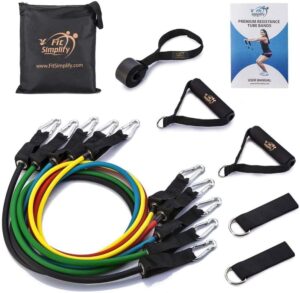
How to Care for Resistance Bands
Before using any type of resistance band, check it carefully for tears, nicks or any other damage. If you anchor it to something rough or sharp, it can be easy to damage. Even a small tear can cause weakness and you don’t want it snapping halfway through an exercise.
You can choose from circular resistance bands, figure-8s, double bands, and so on. However, if you’re new to using them, it’s a good idea to get the simple long tube with handles.
Once you are familiar with that type, you might like to buy some more bands. They don’t cost a lot and can be used in many different ways. Try incorporating resistance bands into your workouts for some variety. You will soon begin to see and feel the results of this new challenge and see your body taking on a new lean and fit shape!
